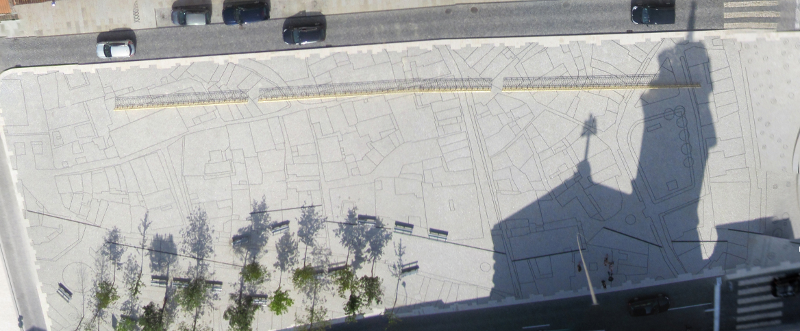
Maps Created by Everybody
James’ practice is frequently concerned with networks, technologies and maps. In particular, he is interested in the ways in which technology understands and represents “our” world, and the ways in which we in turn have our understandings of and behaviour in the world mediated by technologies.
The Open City strand of Guimarães 2012 defines openness as ranging from the personal to the political, innovation to infrastructure. In my view, openness can also take on a number of frequently oppositional forms: an openness to outside elements which might also denude the subject of its individuality, an openness to representations controlled not by citizens but by those same outside elements. Each of these threats is again an opportunity, for cities and citizens to use technology to reach out, present themselves, and control their own representations.
Mapping technologies are a form of “public knowledge”: that is, they represent and communicate a shared understanding of territories, landscapes and cities; and strongly affect our understandings of those places. Maps are influential: they decide behaviours, particularly as visitors but even for citizens. As Jane Jacobs notes in The Death and Life of Great American Cities: “We are all accustomed to believe that maps and reality are necessarily related, or that if they are not, we can make them so by altering reality.”
The programme of Guimarães 2012 is to do both of these things: to alter both the map and the reality of the city through interventions, artworks and new perspectives. But how is this remapping made public, made visible, and most importantly, made “open”?
The workshops:
James will deliver a project called Created By Everybody, which will consist of two different participatory mapping workshops: ‘Walking the Streets’ and ‘Walking the Sky’.
The intention of the project is to undertake a number of mappings of Guimarães with the help and involvement of the public, through workshops and actions. There are two types of mapping, with different technological and infrastructural requirements, which can each be explored and evolved in workshops before being put into practice in the city.
LCD is a place dedicated to creativity, experimentation and multidisciplinary collaboration in the field of digital arts and multimedia for project development, training and research at the intersection between art, science and technology and we are very excited to collaborate with them.
The workshops are supported by the Pop Up programme in Guimarães 2012.
First workshop ‘Walking the Streets’:
|
James Bridle’s presentation of the first workshop, instructions on how to keep mapping and lots of interesting links on his blog: http://booktwo.org/notebook/mapping-workshop-guimaraes/
Second workshop ‘Walking the Sky’
|
James Bridle’s presentation of the second workshop, instructions on how to keep mapping and lots of interesting links on his blog: http://booktwo.org/notebook/balloon-workshop-guimaraes/
Video by Guimaraes TV of the balloon mapping workshop
Mapas gerados por todos
A ação de James está frequentemente preocupada com redes, tecnologias e mapas. Em particular, ele está interessado na forma como a tecnologia entende e representa o “nosso” mundo, e a forma como nós, por sua vez compreendemos e nos comportamos num mundo mediado por tecnologias.
A vertente Cidade Aberta de Guimarães 2012 define a abertura que vai desde o pessoal ao político, da inovação à infraestrutura. Na minha opinião, a abertura também pode assumir um número de formas muitas vezes opostas: uma abertura para elementos externos que também pode desnudar o sujeito da sua individualidade, uma abertura para representações não controladas por cidadãos, mas por esses mesmos elementos externos. Cada uma dessas ameaças é novamente uma oportunidade, para as cidades e os cidadãos usar a tecnologia para alcançar, apresentar-se, e controlar as suas próprias representações.
Tecnologias de mapeamento são uma forma de “conhecimento público”: ou seja, eles representam e comunicam uma compreensão partilhada dos territórios, paisagens e cidades, e afetam fortemente a nossa compreensão desses lugares. Mapas são influentes: eles decidem comportamentos, particularmente a visitantes, mas mesmo para os cidadãos. Como observa Jane Jacobs em The Death and Life of Great American Cities: “Estamos todos acostumados a acreditar que os mapas e a realidade estão necessariamente relacionados, ou que se eles não estão, podemos torná-los assim, alterando a realidade.”
O programa de Guimarães 2012 é fazer ambas as coisas: alterar tanto o mapa como a realidade da cidade através de intervenções, obras de arte e novas perspetivas. Mas como é este remapeamento feito público, visível, e mais importante, “aberto”?
As workshops/oficinas:
James vai apresentar um projeto designado Created By Everybody, que será composto de duas diferentes oficinas de mapeamento participativo: ” Walking the Streets/Andando pelas ruas” e “Walking the Sky/Andando pelo céu”.
A intenção do projeto é realizar uma série de mapeamentos de Guimarães com a ajuda e participação do público, através de workshops e ações. Existem dois tipos de mapeamento, com diferentes requisitos tecnológicos e de infra-estrutura, que podem ser explorado e desenvolvido nas workshops antes de serem colocados em prática na cidade.
O Laboratório de Criação Digital é um espaço dedicado à criatividade, experimentação e à colaboração multidisciplinar no domínio das artes digitais e multimédia com vista à criação, formação e investigação na intersecção entre a arte, ciência e tecnologia.
As oficinas são apoiadas pelo programa Pop Up em Guimarães 2012.
Fotos da primeira workshop:
|
A apresentação da primeira workshop de James Bridle, instruções sobre como manter o mapeamento e outros links interessantes no seu blog: http://booktwo.org/notebook/mapping-workshop-guimaraes/

